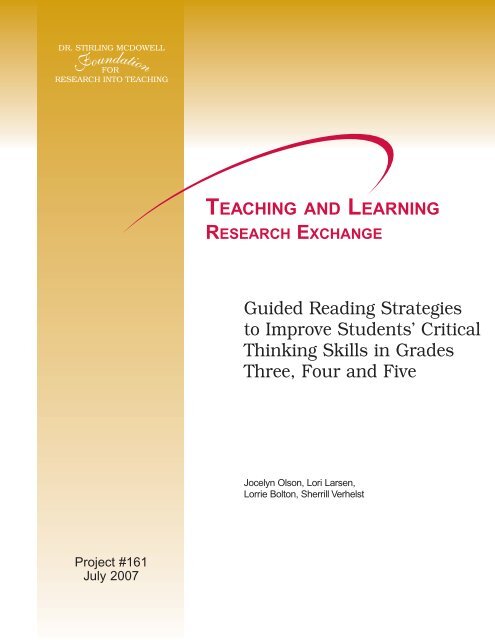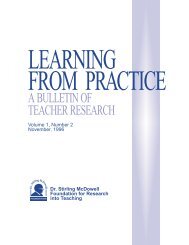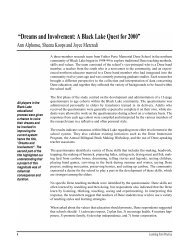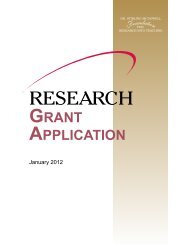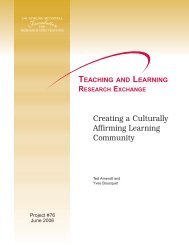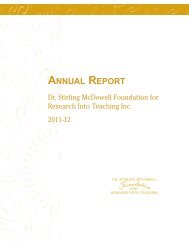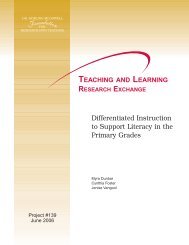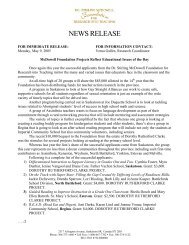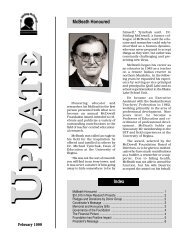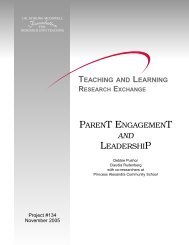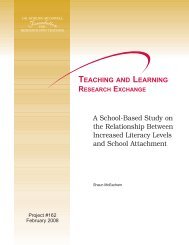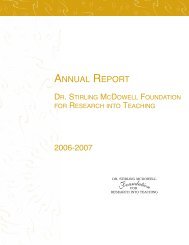Guided Reading Strategies to Improve Students - Dr. Stirling ...
Guided Reading Strategies to Improve Students - Dr. Stirling ...
Guided Reading Strategies to Improve Students - Dr. Stirling ...
- No tags were found...
You also want an ePaper? Increase the reach of your titles
YUMPU automatically turns print PDFs into web optimized ePapers that Google loves.
IntroductionTHE RESEARCHERSFour teachers from St. Olivier School collaborated on this project. Lori, theGrade Three teacher, had seventeen years of teaching experience; Jocelyn, theStudent Services teacher and Resource Based Learning Consultant, had eight yearsof teaching experience along with eight years of experience as a librarian; Lorrie,the Grade Five teacher, had eight years of teaching experience; and Sherrill, theGrade Four teacher, had five years of teaching experience. The <strong>to</strong>tal number ofyears of teaching experience was 38 years. This was their first action researchproject.THE LEARNING COMMUNITYThe students involved in the project attended St. Olivier School in Radville, a smallrural community of about 900 people located about 70 kilometers south ofRegina, Saskatchewan. There was a <strong>to</strong>tal population of 110 students at thebeginning of the 2006/2007 school year. There were 16 students in the GradeThree class, 11 students in the Grade Four class, and 14 students in the GradeFive class. For the last five years, instruction occurred in the alternate-four dayschool week format with a <strong>to</strong>tal of 197 instructional days.In the past, the researchers had collaborated on implementing new curriculum,teaching library skills and computer skills, and doing Literature Circles, as well asworking on GrassRoots projects in Math, Science, and Social Studies designed <strong>to</strong>integrate technology in<strong>to</strong> the curriculum.Full support <strong>to</strong> collaborate on this project, in order <strong>to</strong> develop students’ literacy andthinking skills, was provided by both our Direc<strong>to</strong>r of Education and our schoolprincipal.FIGURE 1. SCHOOL LOGO.RESEARCH REPORT: <strong>Guided</strong> <strong>Reading</strong> <strong>Strategies</strong> <strong>to</strong> <strong>Improve</strong> <strong>Students</strong>’ Critical Thinking Skills in Grades Three, Four and Five1
RESEARCH AT THE DIVISION LEVELWithin the Holy Family School Division, two other action research projects werealready underway. Sheila Dosch at St. Mary’s School in Estevan was investigating<strong>Guided</strong> <strong>Reading</strong> <strong>to</strong> <strong>Improve</strong> <strong>Reading</strong> Instruction in a Grade One Classroom while agroup of primary teachers, from across the division, were involved in Kindergarten<strong>to</strong> Grade Three: <strong>Improve</strong>d Literacy Success Through Assessment and Evaluation.Both focused on improving students’ literacy outcomes. The goal of the Holy FamilySchool Division’s Kindergarten <strong>to</strong> Grade Three <strong>Reading</strong> Initiative was that 95% ofstudents would be reading at grade level or higher by the end of Grade Three,starting with the Kindergarten class of 2005/2006.As a result, the following question was posed:How could further research be used <strong>to</strong> help improve students’comprehension levels, particularly higher level thinking skills, giventhe results of the 2005 AFL <strong>Reading</strong> Assessment, and within theframework of the other research being conducted within the schooldivision?GATHERING TEACHER SUPPORT FOR THE PROJECTIn March of 2006 the Student Services teacher started gathering professionalreading and training materials on <strong>Guided</strong> <strong>Reading</strong> and critical thinking. The ideaof doing a project was discussed with teachers following the 2006 Term 2reporting period, when the Student Services teacher met individually with eachteacher <strong>to</strong> follow-up student needs after report cards. The interest and support fromteachers in Grades Three, Four and Five was very positive. A research question wasformulated and a proposal submitted <strong>to</strong> the <strong>Dr</strong>. <strong>Stirling</strong> McDowell Foundation bythe end of March.RESEARCH REPORT: <strong>Guided</strong> <strong>Reading</strong> <strong>Strategies</strong> <strong>to</strong> <strong>Improve</strong> <strong>Students</strong>’ Critical Thinking Skills in Grades Three, Four and Five3
Research QuestionHow can <strong>Guided</strong> <strong>Reading</strong> strategies be used <strong>to</strong> improve students’critical thinking skills in Grades Three, Four and Five?PURPOSE AND RESEARCH OBJECTIVESThe researchers collaborated in order <strong>to</strong> identify the best <strong>Guided</strong> <strong>Reading</strong>strategies available <strong>to</strong> improve student-learning outcomes in a variety of subjectareas. The objective of this action research project was <strong>to</strong> help fill in some of thegaps identified by the Grade Five provincial reading assessment (2005) bydeveloping students’ critical thinking skills in Grades Three, Four and Fivethrough explicit teaching of <strong>Guided</strong> <strong>Reading</strong> strategies. The project was intended<strong>to</strong> be both data-driven and student-centered and was designed both <strong>to</strong> informteaching practices and <strong>to</strong> develop students’ higher-level comprehension skills.By deepening students’ involvement and understanding of what they were readingand providing lots of opportunities <strong>to</strong> practice the strategies, it was hoped thatstudents would never respond <strong>to</strong> a question with “I don’t know”; instead they wouldthink critically, choose one of the wide varieties of strategies at their disposal andrespond positively.4 RESEARCH REPORT: <strong>Guided</strong> <strong>Reading</strong> <strong>Strategies</strong> <strong>to</strong> <strong>Improve</strong> <strong>Students</strong>’ Critical Thinking Skills in Grades Three, Four and Five
<strong>Students</strong> were taught how <strong>to</strong> use graphic organizers <strong>to</strong> record the main character,the setting, the problem, the solution, and the resolution of a s<strong>to</strong>ry. Afterwards,students were given end of selection (s<strong>to</strong>ry) tests and their reading comprehensionskills were measured with the Qualitative <strong>Reading</strong> Inven<strong>to</strong>ry (1995) in second andthird grade. Anderson, O’Leary, Schuler, and Wright concluded that consistent useof graphic organizers, and an effective <strong>Guided</strong> <strong>Reading</strong> program increasedstudents’ comprehension skills.Several journal articles also shed some light on other ways <strong>to</strong> improve readingcomprehension using higher level thinking skills. Ketch (2005) argued thatconversation can be a vehicle <strong>to</strong> practice and learn comprehension skills. Inresearch conducted on proficient readers, seven common strategies that goodreaders use <strong>to</strong> comprehend text were identified:• making connections <strong>to</strong> the text, the world, and oneself,• questioning as one reads,• using mental imagery <strong>to</strong> make a movie in one’s mind,• determining importance,• inferring,• retelling and synthesizing, and• employing fix-up strategies <strong>to</strong> correct and moni<strong>to</strong>r meaning.Explicit modeling of the strategies, authentic student discussions, practice andstudent reflection time, Ketch noted, helped students “<strong>to</strong> build empathy,understanding, respect for different opinions, and ownership of the learningprocess.”Five common formats used for classroom conversations were: 1) whole group, 2)small group, 3) Literature Circles, 4) think/pair/share, and 5) individualconferences between teachers and students.After over 30 years observing students using the strategies, Ketch came <strong>to</strong> thefollowing conclusion: <strong>Students</strong> actively engaged in the conversation processcan, over time, become reflective critical thinkers.Applegate, Quinn and Applegate (2002) promoted the idea of creating thoughtfulliteracy by studying different kinds of open-ended questions, and thinkinglevels used on eight of the most widely used informal reading inven<strong>to</strong>ries (IRIs).Four types of open-ended questions were classified: literal, low-level inference, highlevelinference, and response items. Two narrative passages and comprehensionquestions from pre-primer through sixth grade were analyzed. Narrative passageswere used because the researchers felt that “higher-level items are more likely <strong>to</strong>be found in response <strong>to</strong> narrative text.”The researchers were particularly interested in what type of message the kind ofquestions asked on IRIs conveyed <strong>to</strong> students about reading. They found that mos<strong>to</strong>f the questions on IRIs (91%) were recall or low-level inferences. On the mostdemanding IRIs, less than a fifth of the questions required more than basicrecall or low-level thinking. The researchers argued,If the IRIs that we use <strong>to</strong> assess children are insensitive <strong>to</strong> thedifferences between recalling and thinking about text, our ability <strong>to</strong>provide evidence of any given child’s instructional needs, let alonehave an impact upon instruction, is severely limited.RESEARCH REPORT: <strong>Guided</strong> <strong>Reading</strong> <strong>Strategies</strong> <strong>to</strong> <strong>Improve</strong> <strong>Students</strong>’ Critical Thinking Skills in Grades Three, Four and Five7
The researcher discovered that “[t]he sixth-grade struggling readers involved inopen-ended reader response instruction actually found it easier and moreinteresting than their previous reading instruction, which sought one predeterminedright answer” (p. 540).Within a social constructivist approach, Primeaux discovered there were manyopportunities <strong>to</strong> help struggling readers comprehend text.Pitts (1991) pointed out that functional illiteracy is a pervasive problem inAmerican society and with many changes <strong>to</strong> educational programs and services,the onus has been placed on classroom teachers <strong>to</strong> create a nation of readers.Using classroom examples from fourth <strong>to</strong> eleventh grade, and documentation fromleading reading specialists, Pitts called for a shift in instruction. Sevenstraightforward strategies were recommended:1) Teach students how <strong>to</strong> use a textbook by brains<strong>to</strong>rming, and discussing thevarious parts, before reading,2) Teach background vocabulary, use warm-up drills <strong>to</strong> teach students how<strong>to</strong> spell key content area words, and review them daily,3) Prepare study guides with inquiry-type questions <strong>to</strong> help studentsunderstand content area subjects,4) Teach students how <strong>to</strong> adjust their reading pace, (read <strong>to</strong> skim, analyze, orread for details) depending on the text,5) Teach students <strong>to</strong> summarize content in their own language,6) Teach students <strong>to</strong> outline using the main idea, and supporting details, and7) Teach students <strong>to</strong> read about different disciplines in their recreationalreading, and <strong>to</strong> share what they learn at school.According <strong>to</strong> Pitts, “Comprehension is the nucleus of learning.” She summarizedher findings by indicating that effective use of these strategies can aidcomprehension, enhance vocabulary, and promote critical thinking.Block (1993) wrote about the effects of a program designed <strong>to</strong> improve thinkingstrategies, reading comprehension achievement, self-esteem, and criticalthinking abilities. Based on the work of Baron and Sternberg; Beyer; Collins; deBono; Marzano, Jones and Brandt; and Paul, eight categories were identified. Theywere:1) basic cognitive operations,2) fundamental thinking processes,3) decision-making strategies,4) problem-solving strategies,5) metacognitive strategies,6) creative thinking strategies,7) strategies for working effectively with groups, and8) strategies for studying and working.Sixteen lessons, based on these strategies, were designed <strong>to</strong> explicitly teachKindergarten through eleventh grade students in several schools in the southwesternUnited States for 1 1/2 hours a day, 2 days a week, for 32 weeks,throughout the school year.RESEARCH REPORT: <strong>Guided</strong> <strong>Reading</strong> <strong>Strategies</strong> <strong>to</strong> <strong>Improve</strong> <strong>Students</strong>’ Critical Thinking Skills in Grades Three, Four and Five9
After a teacher explanation and modeling of a thinking and reading comprehensionstrategy, students selected children’s literature from eight genres (fiction, nonfiction,poetry, au<strong>to</strong>biographies, biographies, folk literature, periodicals, and sciencefiction) in order <strong>to</strong> read and apply the strategy. <strong>Students</strong> were given one-pagethinking guides <strong>to</strong> put on their desks as they read. The guides had a chart and adiagram of a thinking strategy. <strong>Students</strong> discussed how <strong>to</strong> use the thinking guidewhile reading and in their own lives. Finally, students set their own readingobjectives and self-assessed their use of the strategy, and how they could apply i<strong>to</strong>utside school.The 178 students involved in the study did better than the 174 controls on readingcomprehension standardized tests, on transferring thinking strategies outside ofschool, as well as on self-esteem, and on critical and creative thinking measures.Block recommended concentrating on 4 or 5 strategies so students could becomemasters of them, teaching a strategy in a Language Arts block, and thencontinuing strategy instruction with a Science or Social Studies text later in the day.Making predictions was the strategy, promoted in an article by Blevins (1990),<strong>to</strong> enhance students’ reading comprehension. He recommended:• providing explicit instruction about how, when, and why the strategy canbe used,• modeling by using a think-aloud, allowing for practice, and havingstudents articulate their use of the strategy,• asking probing questions, before reading,• using s<strong>to</strong>ry maps for fiction, and• using lists of main ideas so students can fill in supporting details for nonfiction.One source discussed the use of specific anchor lessons and teacher modeling<strong>to</strong> teach young children <strong>to</strong> infer, based on the work of Keene and Zimmerman(1997) in Mosaic of thought: Teaching comprehension in a reader’s workshop,published by Heinemann. The source was <strong>Reading</strong> with meaning: Teachingcomprehension in the primary grades by Miller (2002). Through direct instruction,students were taught how <strong>to</strong>:• infer meanings of unknown words,• make predictions, confirm or contradict them by reading on,• use prior knowledge, text, and picture clues <strong>to</strong> draw conclusions,• infer the meaning of poetry,• know when <strong>to</strong> infer (when the answers they need are not stated in thetext),• ask questions as they read,• create interpretations <strong>to</strong> enrich and deepen their experience in a text, and• make connections <strong>to</strong> their own lives <strong>to</strong> enhance understanding.Specific examples were given of multi-column charts, which were frequentlyused in the classroom:• a word – what we infer – what helped us,• our predictions – and the thinking behind them,10 RESEARCH REPORT: <strong>Guided</strong> <strong>Reading</strong> <strong>Strategies</strong> <strong>to</strong> <strong>Improve</strong> <strong>Students</strong>’ Critical Thinking Skills in Grades Three, Four and Five
• a poem, on one side – what the words mean, on the other side – I’minferring. . ., below, as well as• questions we have – answers <strong>to</strong> these questions.Many student writing and drawing samples were used effectively <strong>to</strong> demonstratehow primary students could be taught <strong>to</strong> infer.COMMON THEMES IN THE LITERATUREAs researchers, we asked ourselves:• What common themes appeared in the literature on comprehension andcritical thinking instruction?• Which strategies were the most effective?According <strong>to</strong> Bird (1989), who was concerned about the ability of university andcommunity college students <strong>to</strong> think critically, “In the area of critical thinking andcomprehension, there exists no single approach <strong>to</strong> student mastery” (p. 745).However, a lot of common themes were evident in this literature review. Many ofthe approaches involved the use of before reading, during reading, and after readingactivities. Instruction was explicit. The teacher modeled the strategy. <strong>Students</strong> weretaught when and how <strong>to</strong> use the strategy, and were also given opportunities <strong>to</strong>practice and reflect on their use of the strategy. Instruction was also studentcentered.<strong>Reading</strong> materials were at the students’ reading levels and based onstudents’ interests. Critical thinking skills were used <strong>to</strong> engage students inreading, writing, listening, and discussions about their ideas.As far as the teaching of specific strategies is concerned, several strategies cameup repeatedly in the literature. The most effective ones that improved students’reading comprehension and critical thinking skills appeared <strong>to</strong> be:• visualizing or making a movie in one’s mind,• teaching background vocabulary,• using graphic organizers (s<strong>to</strong>ry maps, in particular),• using Literature Circles,• questioning when reading,• making connections with the characters,• retelling, and• teaching inferring.From a practical point of view, the frequency and duration of the instruction variedconsiderably. The length of instruction varied from 30 minutes at a time up <strong>to</strong> a76 minute block, from two <strong>to</strong> five days a week, and from four months <strong>to</strong> all year.RESEARCH REPORT: <strong>Guided</strong> <strong>Reading</strong> <strong>Strategies</strong> <strong>to</strong> <strong>Improve</strong> <strong>Students</strong>’ Critical Thinking Skills in Grades Three, Four and Five11
Research MethodologyPARENTAL CONSENTThe researchers wrote a letter <strong>to</strong> inform parents of students in Grades Three, Fourand Five about their intent <strong>to</strong> conduct an action research project on <strong>Guided</strong><strong>Reading</strong> (see Appendix 1). The letter also reassured parents that the results forindividual students would be kept confidential. The information was sharedwith parents at an Open House, early in September 2006. Parents were also asked<strong>to</strong> sign a permission form <strong>to</strong> release student work and <strong>to</strong> allow pho<strong>to</strong>graphs of theirchild(ren) <strong>to</strong> be taken (see Appendix 2). The letter and permission form were senthome <strong>to</strong> any parents who were unable <strong>to</strong> attend the Open House. Parentalsupport was unanimous. Interestingly enough, one high school teacher commentedthat if the researchers were able <strong>to</strong> teach students <strong>to</strong> infer, she would like us <strong>to</strong>share that information since she was trying <strong>to</strong> teach the same skills <strong>to</strong> middle yearsstudents. Her comment raised the question:If students are taught how <strong>to</strong> infer now, will they be able <strong>to</strong> later on,when the material is more difficult?RESEARCHER TRAININGAs researchers, how did we begin the process of learning about <strong>Guided</strong> <strong>Reading</strong>strategies? The researcher-training portion of the project had five main components:1) studying specific strategies used <strong>to</strong> teach <strong>Guided</strong> <strong>Reading</strong> in the professionalliterature,2) viewing and discussing a training video on using <strong>Guided</strong> <strong>Reading</strong> strategies,3) visiting other teachers who successfully use <strong>Guided</strong> <strong>Reading</strong> in theirclassrooms <strong>to</strong> enhance critical thinking,4) keeping reflective journals <strong>to</strong> document insights about <strong>Guided</strong> <strong>Reading</strong>, and5) sharing key findings with the other researchers during regular meetingsthroughout the project.After the Student Services teacher gathered resources and previewed professionalvideos, the researchers met for training in late September of 2006. The purposesof the training were <strong>to</strong> learn more about what <strong>Guided</strong> <strong>Reading</strong> is, identify some ofthe key strategies available, and determine practical ways <strong>to</strong> use the strategies inthe classroom. An education student from the University of Regina, Jessica LaPointe, also attended the training session. The researchers met outside theschool at a local church and watched an informative video, Instructional strategiesfor <strong>Guided</strong> <strong>Reading</strong> that enhance students’ reading comprehension, Grades 3-6(2002). The accompanying resource guide served as the basis for discussion.The video presented six instructional strategies:• I wonder,• good reader strategies, and• the keyword strategy on Tape 1, as well as• making it real,12 RESEARCH REPORT: <strong>Guided</strong> <strong>Reading</strong> <strong>Strategies</strong> <strong>to</strong> <strong>Improve</strong> <strong>Students</strong>’ Critical Thinking Skills in Grades Three, Four and Five
• word sorts, and• anticipation guides on Tape 2.Uses of the strategies were demonstrated using a variety of fiction and non-fictiontexts. Linda Hoyt effectively emphasized that reading is thinking and showed howthe strategies could be utilized <strong>to</strong> improve reading comprehension by stimulatingdeeper, more critical thinking.During the viewing, the researchers s<strong>to</strong>pped the tapes, made notes, discussed eachof the strategies, and began <strong>to</strong> consider which ones they would implement in theirclassrooms. Several questions were raised:• How are students grouped for <strong>Guided</strong> <strong>Reading</strong>?• How does it work when siblings of different ages read at similar levels?• What are other students doing while the teacher is working with agroup?• How are quieter students involved in the discussions?• What materials are used?• How can enough copies of reading materials be made available?BENCHMARKS<strong>Students</strong> were given the Star test in August 2006 <strong>to</strong> help determine their readinglevels and grade equivalents. Testing occurred again before each of the reportingperiods in November, February/March, and May <strong>to</strong> follow up these initialbenchmarks.STRATEGY INSTRUCTIONExplicit teaching of the strategies was the next focus of the research project. Afterthe researcher training, each researcher chose <strong>to</strong> focus on selected strategies thatwould best meet the needs of her students and fit with the work in the units beingtaught in the classroom. The individual approach each researcher <strong>to</strong>ok wasdiscussed and compared during reflection meetings. Highlights were as follows.THE TEACHING APPROACH IN GRADE THREEIn the Grade Three classroom, the researcher used a variety of strategies <strong>to</strong>bring the written word alive. I wonder… was used across the curriculum, eitherbefore reading, during reading or after reading. <strong>Students</strong> completed this sentencestem by recording their responses. The strategy became routine throughout the daywhether it was during read-aloud by the teacher or in Science class.The Keyword strategy was used <strong>to</strong> teach students <strong>to</strong> identify key words orphrases. It was especially useful when students were reading Science-relatedinformation sheets or doing Math s<strong>to</strong>ry problems. <strong>Students</strong> were asked <strong>to</strong>highlight key words or phrases after reading the information over once or twice.Another strategy the researcher focused on was teaching students <strong>to</strong> visualize thewritten word in their minds. A poster was displayed in each classroom <strong>to</strong> remindstudents <strong>to</strong> read and then <strong>to</strong> s<strong>to</strong>p and make a picture. The novel, Owls in theFamily, was read chapter by chapter <strong>to</strong> the students. After listening and readingRESEARCH REPORT: <strong>Guided</strong> <strong>Reading</strong> <strong>Strategies</strong> <strong>to</strong> <strong>Improve</strong> <strong>Students</strong>’ Critical Thinking Skills in Grades Three, Four and Five13
the chapter, students illustrated a scene from it (see Appendix 4a: Imagery withOwls in the Family). The novel was brought <strong>to</strong> life. <strong>Students</strong> enjoyed illustrating anevent from the chapter, and the book became very real <strong>to</strong> them. Every student wasable <strong>to</strong> complete this task; artistic ability did not matter. As visualizing continuedthroughout the year, students became very adept at making pictures in theirminds. It was a valuable reading comprehension strategy <strong>to</strong> make the written wordbecome real.Figure 2. Visualizing poster used by the researchers.After seeing the leveled books available through subscriptions from the web site,<strong>Reading</strong> a-z, used for <strong>Guided</strong> <strong>Reading</strong>, the Grade Three researcher used thes<strong>to</strong>ries, lesson plans, worksheets including s<strong>to</strong>ry maps, and the Reader QuickCheck with the Grade Three class as a whole, instead of using them with smallgroups. An Educational Assistant helped prepare the materials. The students foundthe books and the variety of accompanying activities interesting and fun <strong>to</strong> do.<strong>Students</strong> completed these activities easily and independently. The Reader QuickCheck was an excellent instrument for assessing reading comprehension includinghigher level thinking skills such as inferencing and synthesizing. These printablebooks and teaching materials were a very successful addition <strong>to</strong> a folktale unit.14 RESEARCH REPORT: <strong>Guided</strong> <strong>Reading</strong> <strong>Strategies</strong> <strong>to</strong> <strong>Improve</strong> <strong>Students</strong>’ Critical Thinking Skills in Grades Three, Four and Five
THE TEACHING APPROACH IN GRADE FOURDirect <strong>Guided</strong> <strong>Reading</strong> instruction was the focus for a novel study on S<strong>to</strong>ne fox byJohn Reynolds Gardiner (1980). <strong>Students</strong> participated in a variety of activitiesdesigned <strong>to</strong> promote higher level thinking skills from Literature and criticalthinking, Book 1 by John Carratello. <strong>Students</strong> read up <strong>to</strong> Chapters 5 and 6, andthen did an activity about being a responsible person. In the novel, they learnedthat the main character had many responsibilities so then the students had <strong>to</strong>connect the book <strong>to</strong> their own lives. <strong>Students</strong> had <strong>to</strong> think of how and in whatways they were responsible. They also had <strong>to</strong> write if they thought they could carefor their Grandpa like the character Little Willy had <strong>to</strong> and answer why or why not.Then they had <strong>to</strong> think of five ways that they could earn $500, like Little Willy. Theideas had <strong>to</strong> be real ways and not “make-believe.” The students also had <strong>to</strong> writea prediction of whom they thought would win the big race, and what theythought would happen. Then they read the book <strong>to</strong> find out. Afterwards, theywatched the video, S<strong>to</strong>ne Fox. <strong>Students</strong> recorded the similarities and differencesbetween the book and the video.<strong>Students</strong> reading the novel, S<strong>to</strong>ne Fox, Grade 4.After reading, the Grade Four students filled in a Literature Log. This pageincluded the following stems: the best part was…, the worst part was…, the mainproblem was…, problem was solved when…, my favorite character was…, my leastfavorite character was…, I laughed when…, and I cried when….Following the novel study, the Grade Four students’ comprehension levels wereassessed on the computer in a variety of ways. <strong>Students</strong> did an Accelerated Readerquiz with ten questions on the novel <strong>to</strong> help measure their basic comprehensionskills. Then they did a Vocabulary quiz, and something new – a Literacy Skills quiz.The Vocabulary test had five multiple-choice type questions on the meaning of avariety of words from the novel. On the Literacy skills quiz, students were asked<strong>to</strong> answer 12 questions. There were four categories on the S<strong>to</strong>ne Fox Literacy Skillsquiz, each with three questions:1) initial understanding,2) literacy analysis,3) inferential comprehension, and4) constructing meaning.RESEARCH REPORT: <strong>Guided</strong> <strong>Reading</strong> <strong>Strategies</strong> <strong>to</strong> <strong>Improve</strong> <strong>Students</strong>’ Critical Thinking Skills in Grades Three, Four and Five15
Inferential comprehension included comparing and contrasting, drawingconclusions, extending meaning, making inferences, making predictions, andrecognizing cause and effect. This was the first time a class at St. Olivier Schoolhad done a Literacy Skills quiz. Questions went beyond basic recall <strong>to</strong> challengestudents <strong>to</strong> think more deeply. The Class Summary Report provided usefulinformation that will be discussed in the Data Summary section of this report.Computer assessment of Grade 4 students with Literacy quizzes.THE STUDENT SERVICES TEACHER’S APPROACH IN GRADE FOURTo begin with, students were <strong>to</strong>ld that the researcher’s goal, at the beginning of theyear, was <strong>to</strong> teach them how <strong>to</strong> think. Throughout the year, visualizing by makingmind movies, the use of a variety of graphic organizers, the application of the Iwonder… and I think… strategies, direct instruction on inferring using text and visualclues, and many opportunities <strong>to</strong> practice the strategies paved the way for theimplementation of a researcher-made <strong>Guided</strong> <strong>Reading</strong> unit at the end of the year.<strong>Students</strong> participated in a seven-week unit: Meet the Canadian Author andIllustra<strong>to</strong>r, C. J. Taylor. <strong>Guided</strong> <strong>Reading</strong> occurred in 30-minute periods four timesa week. The Star test, and results from informal reading inven<strong>to</strong>ries were used <strong>to</strong>determine students’ reading levels and <strong>to</strong> create three reading groups: theWarriors, the White Buffalos, and the Wigwams. Picture cards based on thelegends students would be reading were posted on the whiteboard <strong>to</strong> indicate whatgroups students were in, and what their daily tasks were.INSERT PHOTO #3<strong>Students</strong> involved in a small <strong>Guided</strong> <strong>Reading</strong> group on Nativelegends, Grade 4.16 RESEARCH REPORT: <strong>Guided</strong> <strong>Reading</strong> <strong>Strategies</strong> <strong>to</strong> <strong>Improve</strong> <strong>Students</strong>’ Critical Thinking Skills in Grades Three, Four and Five
HOW WOULD STUDENTS REACT TO BEING GROUPED ACCORDING TO ABILITY?The researcher explained what kinds of books and the specific kinds of activitiesstudents would be doing. For example, the Warriors were students who liked longerchapter books with challenging vocabulary and who created more detailed kindsof writing. The White Buffalos read shorter books including a few collections ofcreation s<strong>to</strong>ries with some new words; they enjoyed shorter writing tasks. TheWigwams were those students who liked reading a short s<strong>to</strong>ry, learning a few newwords, and who were capable of writing good answers with fewer details. Thestudents readily accepted these explanations, and they were keen <strong>to</strong> get started.HOW COULD STUDENTS BE MOTIVATED TO THINK CRITICALLY AT THE END OF THEDAY? WOULD THEY BE ABLE TO STAY ON TASK IN THEIR GROUPS, AND AT TIMESWORK INDEPENDENTLY?Because the <strong>Guided</strong> <strong>Reading</strong> groups were small, the materials for this unitconsisted of picture books borrowed from the Public Library system. <strong>Students</strong> weregiven books <strong>to</strong> read at their independent level, ranging from Grade 3.3 <strong>to</strong> 5.9. Thepaintings on the covers were very appealing. Checklists were created for each legendso students could self-moni<strong>to</strong>r the tasks they had completed. Tasks weredeveloped for before, during and after reading. These tasks provided opportunitiesfor lots of discussion, vocabulary building, writing answers <strong>to</strong> higher-levelquestions, and creating products such as songs, drawings, and puppet plays.Several graphic organizers were used including:• a K-W-L chart <strong>to</strong> gather information about C. J. Taylor,• pictures with lines for quick writes <strong>to</strong> determine students’ backgroundknowledge,• prediction and confirmation charts,• Venn diagrams and charts <strong>to</strong> compare characters, and• webs <strong>to</strong> categorize kinds of legends.Questioning included a limited number of basic recall-type questions. Instead, theresearcher focused on more open-ended questions and posed several kinds ofhigher-level questions that encouraged students <strong>to</strong>:• make predictions by giving evidence from the text and picture clues,• relate legends <strong>to</strong> their own experience,• apply what they had learned about a character <strong>to</strong> their own lives,• raise questions as they read,• identify the author’s message,• determine meaning by reading and writing words in context,• draw conclusions at the end of the legends,• evaluate favorite legends and paintings, and• answer lots of why do you think… questions.This line of questioning kept students interested and challenged. Discussions werelively and students had <strong>to</strong> think more critically. The researcher <strong>to</strong>ok turnsworking with each group, and observations were recorded.RESEARCH REPORT: <strong>Guided</strong> <strong>Reading</strong> <strong>Strategies</strong> <strong>to</strong> <strong>Improve</strong> <strong>Students</strong>’ Critical Thinking Skills in Grades Three, Four and Five17
Each group read three legends, and <strong>to</strong>ok Accelerated Reader tests on the books,when available, at the end of the activities. The unit concluded with a lunchfeaturing First Nations food. Some students re<strong>to</strong>ld a few of the legends they hadread by performing puppet shows on the last day of school for students inGrades One through Three. <strong>Students</strong> in the audience were asked <strong>to</strong> infer what theauthor’s message was at the end of each legend. Each legend was well received bythe audience.THE TEACHING APPROACH IN GRADE FIVEInstruction started with a fantasy themed unit in English Language Arts. ALiterature Circle approach with small manageable groups with students eachreading at their levels, performing critical and creative thinking tasks, andanswering inferential questions was used. Novels included Tuck everlasting byNatalie Babbitt (1975), A stranger came ashore (1975) by Mollie Hunter, publishedby Harper Trophy, and Allison’s ghost by Canadian authors Mary Alice andJohn Downie (1984). Sentence stems from an English Language Arts workshopwere enlarged, reproduced and laminated. Color-coding was used for before,during, and after reading activities. Cards were made for each of the researchers<strong>to</strong> use with any English Language Arts unit (see Appendix 3 for a detailed list ofthe sentence stems). <strong>Students</strong> also used response journals <strong>to</strong> record I wonder…,I think…, and <strong>to</strong> draw a picture or make notes about their reading under a sectioncalled, “My Space.”The Grade Five researcher engages a Literature Circle group withsentence stem cards.The Grade Five researcher continued <strong>to</strong> develop students’ critical and creativethinking and inferencing skills in a variety of areas across the curriculumbeginning with a cross-curricular Heroes unit. <strong>Students</strong> did four lessons from thebook, Heroes: 21 true s<strong>to</strong>ries of courage and honor – with exercises for developingreading comprehension and critical thinking skills (1999) by Henry Billings andMelissa Billings from James<strong>to</strong>wn Publishers.According <strong>to</strong> Heroes, “When you combine your own experience and informationfrom a text <strong>to</strong> draw a conclusion that is not directly stated in that text, you aremaking an inference” (p.58).<strong>Students</strong> practiced making inferences by:• identifying cause and effect relationships, theme categories, predictions,as well as fact and opinion,18 RESEARCH REPORT: <strong>Guided</strong> <strong>Reading</strong> <strong>Strategies</strong> <strong>to</strong> <strong>Improve</strong> <strong>Students</strong>’ Critical Thinking Skills in Grades Three, Four and Five
• identifying the main idea of each s<strong>to</strong>ry,• recalling details,• working with new vocabulary,• summarizing and paraphrasing,• responding <strong>to</strong> critical thinking exercises,• raising questions, and• making personal responses <strong>to</strong> learn about heroes.In English Language Arts, a <strong>Guided</strong> <strong>Reading</strong> approach was employed using shorts<strong>to</strong>ries, poetry, and essays on Canadian and world heroes.In Social Studies, students learned about Canadian War Heroes/RemembranceDay by reading and responding <strong>to</strong> several information cards from Lest we forget,grades 4-6 (2000) by Ruth Solski, published by S & S Learning Materials.In Guidance, students made personal reflections on the Stations of the Cross anddrew posters <strong>to</strong> represent each station.In Mathematics, personal dictionaries were used <strong>to</strong> help students understandvocabulary, and problem solving duotangs were created <strong>to</strong> help students thinkmore critically. <strong>Students</strong> did the Written Assessment Task, Understanding theProblem on pages 77 through 83 of Alberta Education’s Diagnostic mathematicsprogram: elementary: division II: problem solving (1990). This assessment includeddetermining what information was not needed <strong>to</strong> solve problems and answeringa variety of multiple-choice questions about tables, charts, signs, diagrams, andword problems. <strong>Students</strong> also made their own tables, lists, pictures, and diagrams,or used guess and check <strong>to</strong> answer problems from The Problem Solver 3: Activitiesfor Learning Problem-Solving <strong>Strategies</strong> (1987) by Shirley Hoogeboom and JudyGoodnow, published by Creative Publications.SCHOOL VISITIn January 2007, three of the researchers, armed with questions, visited SacredHeart, an inner-city school in Regina, <strong>to</strong> observe a highly successful <strong>Guided</strong><strong>Reading</strong> program in action. The program was intensive and involved all of thestudents in Kindergarten <strong>to</strong> Grade Eight. The program was facilitated by 18dedicated teachers and three educational assistants and occurred four days a week.Benchmarking was conducted three times a year. <strong>Students</strong> were groupedaccording <strong>to</strong> their reading levels and expected <strong>to</strong> improve one reading level per term.<strong>Reading</strong> materials consisted of benchmarking <strong>to</strong>ols, books, and activity sheetsdownloaded from the <strong>Reading</strong> a-z website. The enthusiasm of all the participantswas clearly evident.RESEARCH REPORT: <strong>Guided</strong> <strong>Reading</strong> <strong>Strategies</strong> <strong>to</strong> <strong>Improve</strong> <strong>Students</strong>’ Critical Thinking Skills in Grades Three, Four and Five19
Sacred Heart Community School, Regina, Saskatchewan taken byLorraine Brecht.Reprinted with permission.After observing <strong>Guided</strong> <strong>Reading</strong> at Sacred Heart, the researchers met with two ofthe teachers <strong>to</strong> get answers <strong>to</strong> any remaining questions. Seeing first-hand how a<strong>Guided</strong> <strong>Reading</strong> program using multi-grade groupings was conducted was aninvaluable experience. Practical ideas about how <strong>to</strong> implement it were gathered andcontinued enthusiasm for the project was generated.ASSESSMENT AND EVALUATION<strong>Students</strong>’ comprehension and thinking skills were assessed in a variety of ways.Computerized assessment included the Star test <strong>to</strong> identify instructional levels andgrade equivalent scores, Accelerated Reader quizzes <strong>to</strong> measure basicunderstanding of the books read, and Literacy quizzes <strong>to</strong> measure higher-levelthinking skills including inferring. Both types of quiz had multiple-choicequestions.We also assessed students’ daily work, i.e., their writing, which included s<strong>to</strong>ry mapsand other graphic organizers, responses <strong>to</strong> written questions, response journals,and interviews, their speaking skills in discussions, oral reading, and retellings, andtheir representational skills in artwork. A <strong>Guided</strong> <strong>Reading</strong> Evaluation checklist wasalso created (see Appendix 5).Student self-assessment included a Fantasy Unit survey in Grade Five (seeAppendix 4d), and a Looking Back at the Unit sheet <strong>to</strong> evaluate the <strong>Guided</strong> <strong>Reading</strong>unit on Native legends in Grade Four.20 RESEARCH REPORT: <strong>Guided</strong> <strong>Reading</strong> <strong>Strategies</strong> <strong>to</strong> <strong>Improve</strong> <strong>Students</strong>’ Critical Thinking Skills in Grades Three, Four and Five
Summary of DataSTUDENT INTERVIEWSWHAT WAS THE STUDENT SAMPLE LIKE? WHAT WERE THESTUDENTS’ INTERESTS? HOW DID THEY SEE THEMSELVES ASREADERS? HOW DID THE GRADE THEY WERE IN AFFECT THEIRPERCEPTIONS?In September 2006, the students in Grades Three, Four and Five were given theStudent Interview, Kindergarten – Fourth Grade from The Critical reading inven<strong>to</strong>ry(2004) <strong>to</strong> gather some background information, including students’ perceptions ofthemselves as readers. <strong>Students</strong> wrote their responses on an interview sheet. Ananalysis of their responses followed, and the results are summarized below.There was an even balance of boys and girls in the sample, with a <strong>to</strong>tal of 22 boys(one boy moved before the March 2007 reading assessment) and 21 girls.<strong>Reading</strong> was the students’ third favorite home activity, rated below watching TVand playing on the computer. <strong>Students</strong> explained that they like reading at homebecause “the book is interesting, reading teaches you stuff, I’m good at reading, Ilike reading because it’s exciting, and I relax.”The number of students who were read <strong>to</strong> at home dropped as the students go<strong>to</strong>lder. The majority of Grade Three students were read <strong>to</strong> at bedtime, while themajority of Grade Four and Five students were not. While it was parents who read<strong>to</strong> most of the Grade Three students, a grandparent read <strong>to</strong> several of thestudents, and a brother or sister read <strong>to</strong> a few.Whether students liked <strong>to</strong> read or not depended on the grade they were in. Themajority of students in Grade Three and Four liked <strong>to</strong> read, while only about halfthe students in Grade Five liked <strong>to</strong> read.There was a wide range of favorite books and authors that depended on the gradestudents were in. The most popular books in Grade Three were the Magic TreeHouse series and Junie B. Jones; in Grade Four students preferred fantasy,animal s<strong>to</strong>ries, and books by Lemony Snicket; and J. K. Rowling’s Harry Potterbooks were the favorites in Grade Five.The students’ perceptions of themselves as good readers varied according <strong>to</strong>grade. The majority of Grade Three and Four students saw themselves as goodreaders, while the Grade Five students were split as <strong>to</strong> whether they sawthemselves as good readers or not.According <strong>to</strong> the majority of the students, no matter what grade they were in, thehardest part of reading was reading words that were hard or long. Otherdifficulties listed were taking an Accelerated Reader test, finding the perfectbook, understanding a book, the fine print in a book, pages that are <strong>to</strong>o long, andthe middle of a book. Several students indicated that nothing about reading washard for them.RESEARCH REPORT: <strong>Guided</strong> <strong>Reading</strong> <strong>Strategies</strong> <strong>to</strong> <strong>Improve</strong> <strong>Students</strong>’ Critical Thinking Skills in Grades Three, Four and Five21
When students were asked what they do when they come <strong>to</strong> a word they do notknow, they gave a variety of responses. The majority of students indicated theysound the word out. This response was followed by those who ask someone forhelp, usually an adult and sometimes a friend, those who re-read the samesentence, those who tried their best; those who split the word in<strong>to</strong> groups or brokeit up, those who looked at the word, those who thought, and those who keptreading or skipped the word. The Grade Five students tended <strong>to</strong> list morestrategies for dealing with unfamiliar words than the younger students.When students were asked where they got the books they read at home, most ofthem recorded the school library as their source of books. Other popular responseswere classroom book orders, gifts, s<strong>to</strong>res, a bookshelf at home, siblings, and las<strong>to</strong>n the list, the public library, which was mentioned by only a few students.When students were asked what they liked most about school, reading wasamong the <strong>to</strong>p five things listed, regardless of the grade the students were in.The majority of students in all three grades thought that reading would beimportant when they were older. However, several students in Grade Three and Fivethought that it would not be important. A few students responded <strong>to</strong> thisquestion with “maybe,” “sometimes” or “a little.”INFORMAL READING INVENTORY RESULTSHow did the students perform on the informal reading inven<strong>to</strong>ries?What was the baseline data like?Did results vary due <strong>to</strong> any of the following:• When the passage was administered?• Who administered the passage?• The student’s gender?• The student’s grade level?• How the passage was read?• The difficulty of the passage?• The kind of passage, i.e., whether it was narrative or informative?Most important, did the students improve their inferencing skills?<strong>Students</strong>’ reading comprehension skills, particularly their inferencing skills, wereassessed through informal reading inven<strong>to</strong>ries three times during the course of theproject.Initially, the researchers decided <strong>to</strong> use a new assessment, The Critical <strong>Reading</strong>Inven<strong>to</strong>ry (2004), with students as a benchmark in September. Substituteteachers, a Grade Twelve student doing work experience, and an EducationalAssistant administered Word lists and passages. However, after reviewing theresults, the researchers found that the passages were much more difficult than theones used before and they questioned some of the choices in the passages that thestudents were given. Deciding that this approach did not assess the students fairly,the researchers chose <strong>to</strong> use inven<strong>to</strong>ries that were familiar <strong>to</strong> them instead.22 RESEARCH REPORT: <strong>Guided</strong> <strong>Reading</strong> <strong>Strategies</strong> <strong>to</strong> <strong>Improve</strong> <strong>Students</strong>’ Critical Thinking Skills in Grades Three, Four and Five
In November, with the support of release time, the researchers administeredinformal reading inven<strong>to</strong>ries of their own choosing. Narrative and/or informativepassages from the Basic <strong>Reading</strong> Inven<strong>to</strong>ry (2001) and the Diagnostic <strong>Reading</strong>program (1989) were used. Each passage had a few inferencing questions.<strong>Students</strong> were reassessed in March and May. Inferring results were graphed <strong>to</strong>compare the students’ results in November and May. (See graphs for each gradebelow.)Note:The sources of the passages were as follows: The Noise – Form B, Johns(2001), Cricket Song – Form D, Johns (2001), A Visit <strong>to</strong> Earth – 3B-2,Alberta Education (1989), Just One More – 4A-N, Alberta Education(1989) and Jen’s Rotten Day – 4D-N, Alberta Education (1989).Grade Three students read three narrative passages in November and twonarrative passages in May. The percentage of students who were inferring inNovember improved significantly when the passage was read orally. A <strong>to</strong>tal of 88%of the students succeeded in making inferences compared <strong>to</strong> 38% and 25%when the passage was read silently. The percentage increased <strong>to</strong> a <strong>to</strong>tal of 94% ofstudents making inferences successfully in May on the passage read orally.However, the percentage of students inferring in May rose significantly <strong>to</strong> 81% onthe passage read silently.RESEARCH REPORT: <strong>Guided</strong> <strong>Reading</strong> <strong>Strategies</strong> <strong>to</strong> <strong>Improve</strong> <strong>Students</strong>’ Critical Thinking Skills in Grades Three, Four and Five23
Note: The sources of the passages were as follows: Just One More – 4A-N,Alberta Education (1989), Grizzly Bears – 4D-I, Alberta Education (1989)and Jen’s Rotten Day – 4D-N, Alberta Education (1989).Grade Four students read a narrative passage in November and both aninformational and a narrative passage in May. <strong>Students</strong> appeared <strong>to</strong> experiencedifficulty with an informational passage that was read orally in May, since only 70%of students succeeded on the inferring questions. However, the <strong>to</strong>tal percentage ofstudents inferring successfully when narrative passages were read silentlyimproved from 80% in November <strong>to</strong> 90% in May.Note:The sources of the passages were as follows: Through the S<strong>to</strong>rm – 5A-N,Alberta Education (1989), Breakaway – 5B-N, Alberta Education (1989),Roller Skating – 5C-I, Alberta Education (1989) and Two Famous Brothers– Form LE I, Johns (2001).24 RESEARCH REPORT: <strong>Guided</strong> <strong>Reading</strong> <strong>Strategies</strong> <strong>to</strong> <strong>Improve</strong> <strong>Students</strong>’ Critical Thinking Skills in Grades Three, Four and Five
Grade Five students read one informational passage orally in November; and onenarrative passage orally, and two informational passages silently in May. Resultsvaried from a <strong>to</strong>tal of 57% of students inferring in November <strong>to</strong> a <strong>to</strong>tal of 86, 50 and86% in May, depending on the passage.STUDENT SURVEY RESULTS FROM GRADE FIVEFANTASY UNITThe results of the survey given <strong>to</strong> Grade Five students at the end of the Fantasyunit can be summarized as follows. The majority of Grade Five students likedworking in groups, predicting, and sharing their opinions. The response <strong>to</strong>before, during, and after reading cards was mixed. Some students appeared <strong>to</strong> needmore time and practice <strong>to</strong> develop their ability <strong>to</strong> fill in the answers <strong>to</strong> thesesentence stems. Response journals with writings or drawings appeared <strong>to</strong> help mos<strong>to</strong>f the students remember or understand what they were reading. It should benoted that Grade Five students’ perceptions of themselves as good readersimproved compared <strong>to</strong> their perceptions during the student interviews given inSeptember.COMPUTERIZED TESTING<strong>Students</strong> did well on their Accelerated Reader tests after learning <strong>Guided</strong> <strong>Reading</strong>strategies. The tests included novel study books and Native legends. Resultsfrom the Literacy Quiz for the novel, S<strong>to</strong>ne Fox, provided detailed information aboutGrade Four students’ inferring skills, including where the students were successfuland where improvement was needed. These results are shown in the table below.LITERACY SKILLS QUIZSUMMARY REPORT ON INFERRING SKILLS, GRADE FOURJune 25, 2007Inferential Comprehension Correct Possible %Comparing and Contrasting 5 5 100<strong>Dr</strong>awing Conclusions 3 4 75Extending Meaning 6 6 100Making Inferences 4 5 80Making Predictions 6 6 100Recognizing Cause and Effect 2 4 50Group Totals 26 30 87RESEARCH REPORT: <strong>Guided</strong> <strong>Reading</strong> <strong>Strategies</strong> <strong>to</strong> <strong>Improve</strong> <strong>Students</strong>’ Critical Thinking Skills in Grades Three, Four and Five25
Researcher ReflectionsWhat did the researchers learn from collaborating on this project?The researchers maintained reflection journals throughout the project. Thefollowing insights are drawn from their unpublished journals for the 2006/2007school year.• The project proved <strong>to</strong> me we are good <strong>Reading</strong> teachers willing <strong>to</strong> learn newstrategies <strong>to</strong> improve and build on what we are already doing everyday in ourclassrooms.• Perhaps our greatest resource for teaching <strong>Reading</strong> already exists in ourschool… the knowledge that we all have in teaching <strong>Reading</strong>.• I do believe that critical and creative thinking can be taught – just <strong>to</strong> themind that is developed and ready for it.• Some children were excellent readers; but were not comfortable or confidentin creative or critical thinking. They appeared <strong>to</strong> be better at learning factualinformation rather than using personal judgment or taking guesses atthings.• It is important that each teacher collect his/her own data with each childwhen screening the children.• Having release time <strong>to</strong> assess students and <strong>to</strong> meet with the otherresearchers was very beneficial.• It is time consuming <strong>to</strong> organize <strong>Guided</strong> <strong>Reading</strong> initially – creating units,gathering materials and determining student groupings.• One highlight of this project was <strong>to</strong> visit Sacred Heart School in Regina.• The opportunity <strong>to</strong> discuss resources, benchmarks, screens, M.I.R. (MajorIntegrated Resources) and assessments was in itself invaluable.• To see the before, during and after posters hanging in the classroomsand being used was an affirmation of the many years I spent on theSaskatchewan Learning K-5 ELA renewal team.• Because of the visit, all my fears of how <strong>to</strong> implement this strategy werealleviated and I have the confidence <strong>to</strong> immerse my class in<strong>to</strong> it.• I’m finding resources more readily now.• The use of technology <strong>to</strong> measure comprehension skills, and specifically theability <strong>to</strong> inference was a valuable <strong>to</strong>ol that not only kept the studentsmotivated, and provided immediate feedback; but created diagnosticprin<strong>to</strong>uts that could be used <strong>to</strong> inform teaching practices as well.• The kinds of questions I ask now are more open-ended, and encouragestudents <strong>to</strong> dig deeper, and think more critically.• The process of learning about the theory of <strong>Guided</strong> <strong>Reading</strong> strategieswith the other researchers and implementing a <strong>Guided</strong> <strong>Reading</strong> program wasan exciting one.26 RESEARCH REPORT: <strong>Guided</strong> <strong>Reading</strong> <strong>Strategies</strong> <strong>to</strong> <strong>Improve</strong> <strong>Students</strong>’ Critical Thinking Skills in Grades Three, Four and Five
• Teaching a small class of 11 students originally and then only 10 students,after one moved, was definitely an advantage <strong>to</strong> pilot a researcher-made<strong>Guided</strong> <strong>Reading</strong> program.• Teaching students <strong>to</strong> infer by giving evidence from the text and/or pictureclues when they are young provides a good foundation for the kinds of higherlevel thinking they will be expected <strong>to</strong> do when they are older.• Teaching <strong>Guided</strong> <strong>Reading</strong> strategies really helped students <strong>to</strong> develop theirvocabulary skills and <strong>to</strong> read words in context.• The opinions students presented during their discussions were interestingand helped them <strong>to</strong> understand other students’ points of view.• The more students predicted what would happen next, the more studentslearned <strong>to</strong> take risks.• <strong>Guided</strong> <strong>Reading</strong> helps the teacher <strong>to</strong> get <strong>to</strong> know students on a morepersonal level, especially when students were given lots of opportunities <strong>to</strong>relate s<strong>to</strong>ries <strong>to</strong> their own experience, and it provided insights in<strong>to</strong> students’successes, interests, fears, etc.• Some students were better able <strong>to</strong> relate s<strong>to</strong>ries <strong>to</strong> movies they had seen,rather than <strong>to</strong> other s<strong>to</strong>ries.• The structure provided by <strong>Guided</strong> <strong>Reading</strong> makes teacher expectations veryclear.• The skill of reading short paragraphs silently in a group needed <strong>to</strong> betaught <strong>to</strong> some students who are used <strong>to</strong> answering a question afterreading aloud as a class.• Grouping students by their independent reading levels meant everyone inthe class was included and could experience success in <strong>Reading</strong>.• This experience has proven <strong>to</strong> be beneficial not only <strong>to</strong> myself as aneduca<strong>to</strong>r, but also <strong>to</strong> my students who have experienced growth in theircritical and creative thinking skills due <strong>to</strong> the exposure of different strategiesand CCT questions across the curriculum.• Next year, I plan <strong>to</strong> try and implement small <strong>Guided</strong> <strong>Reading</strong> groups in otherthemed units.• I would like <strong>to</strong> use the Literacy Quizzes next year for novel studies in myclassroom.• We can learn from each other, pool our ideas <strong>to</strong>gether, discuss what worksand doesn’t work, identify what needs <strong>to</strong> be changed, and teach kids <strong>to</strong> readso that they come <strong>to</strong> love reading and will become hooked on reading.• This research project has been an excellent learning opportunity, andvery worthwhile.RESEARCH REPORT: <strong>Guided</strong> <strong>Reading</strong> <strong>Strategies</strong> <strong>to</strong> <strong>Improve</strong> <strong>Students</strong>’ Critical Thinking Skills in Grades Three, Four and Five27
ConclusionsThe use of <strong>Guided</strong> <strong>Reading</strong> strategies <strong>to</strong> teach students <strong>to</strong> infer and thinkcritically was just one of a multitude of approaches available. The researchers foundthat cross-curricular (Language Arts, Math, Social, Science, and Guidance)critical thinking questions, assignments, and tasks when combined with <strong>Guided</strong><strong>Reading</strong> strategies, could indeed increase students’ critical thinking and inferringskills. In order <strong>to</strong> be successful, <strong>Guided</strong> <strong>Reading</strong> strategies needed <strong>to</strong> be taughtexplicitly and modeled by the teacher, and the students needed <strong>to</strong> be given lots ofopportunities <strong>to</strong> practice them.The way <strong>Guided</strong> <strong>Reading</strong> strategies were taught was very individual, depending onseveral fac<strong>to</strong>rs:• the researcher (level of experience, comfort level, and focus of the teachingunits),• the students (their reading levels, interests, ability <strong>to</strong> work independently,and skills in cooperative group work),• classroom organization (what tasks the other students were doing, e.g.,keyboarding, Creative Writing or participating in another <strong>Guided</strong> <strong>Reading</strong>group),• the availability of materials (access <strong>to</strong> multiple copies and books at students’independent reading levels, and availability of computer accessible materials),• time (a period of at least 30 minutes, more than one day in a row or in ablock of several weeks, and enough time <strong>to</strong> download, print and assemblebooks), and• scheduling (overlapping of the timetable or flexible timetabling, particularlywhere teachers wanted <strong>to</strong> team or co-teach).It definitely <strong>to</strong>ok a lot of time <strong>to</strong> learn the theory behind <strong>Guided</strong> <strong>Reading</strong> and thewide variety of strategies available <strong>to</strong> implement it, as well as prepare the units andgather, create, and organize the necessary reading materials. The improvement instudent outcomes made the effort worthwhile.The researchers concluded that this action research project was just a beginningand they were very much in an awareness/exploration phase. They inferredthat their work with <strong>Guided</strong> <strong>Reading</strong> strategies would continue in 2007/2008, asthey shared what they had learned with other teachers and continued <strong>to</strong> apply thestrategies in their teaching practice. They expected <strong>to</strong> continue building on thisknowledge and applying it in the years ahead.28 RESEARCH REPORT: <strong>Guided</strong> <strong>Reading</strong> <strong>Strategies</strong> <strong>to</strong> <strong>Improve</strong> <strong>Students</strong>’ Critical Thinking Skills in Grades Three, Four and Five
LimitationsThe research was not without limitations related <strong>to</strong> the administration of theinformal reading inven<strong>to</strong>ries, the timing of the school visit, as well as when and how<strong>Guided</strong> <strong>Reading</strong> strategies were taught. These limitations are described in moredetail below.1) The administration of The Critical <strong>Reading</strong> Inven<strong>to</strong>ry could have been betterhandled. Overall, the researchers were dissatisfied with how the passageswere administered. For instance, difficult questions were not repeated orrephrased, and foreign names were not <strong>to</strong>ld <strong>to</strong> the students. The passageswere much longer than the passages administered in the past, and theretelling portion of the inven<strong>to</strong>ry <strong>to</strong>ok more time. <strong>Students</strong> were not asked<strong>to</strong> expand on their retellings through further questions, such as “thenwhat happened?” or “what else?”2) The informal reading inven<strong>to</strong>ries were not used consistently. The researchersadministered passages from two different inven<strong>to</strong>ries (the Diagnostic <strong>Reading</strong>Program and the Basic <strong>Reading</strong> Inven<strong>to</strong>ry) and some used two types ofpassages (narrative and informational), but not consistently. The graphshelped the researchers <strong>to</strong> see how many passages had been administered,from what reading inven<strong>to</strong>ries, and the kinds of passages used.3) The visit <strong>to</strong> Sacred Heart School would have been better organized for thefall as planned rather than in January. This timing would have given theresearchers more practical information about teaching <strong>Guided</strong> <strong>Reading</strong>strategies sooner.4) The <strong>Guided</strong> <strong>Reading</strong> Author Study in Grade 4 should have been completedbefore the Star test and the last informal reading inven<strong>to</strong>ries wereadministered at the end of May.5) Two of the researchers used a whole class approach <strong>to</strong> teaching <strong>Guided</strong><strong>Reading</strong> strategies, while the other two used a small group approach.Multi-grade groupings were not attempted, given the number of siblings thatread at similar levels. Flexible groupings were also not used.6) Parent questionnaires were not part of the research, as originally planned.Parent reflections would have been a useful way <strong>to</strong> involve parents more intheir children’s reading and thinking.RESEARCH REPORT: <strong>Guided</strong> <strong>Reading</strong> <strong>Strategies</strong> <strong>to</strong> <strong>Improve</strong> <strong>Students</strong>’ Critical Thinking Skills in Grades Three, Four and Five29
RecommendationsThis action research project led the researchers <strong>to</strong> formulate the followingrecommendations:1) That the researchers continue <strong>to</strong> collaborate by sharing best practices forteaching <strong>Guided</strong> <strong>Reading</strong> strategies through Professional LearningCommunities (PLC’s);2) That provisions continue <strong>to</strong> be made for teacher release time <strong>to</strong> allow for theadministration of individual reading assessments;3) That the researchers share what they have learned from this project withother teachers who teach Grades Three, Four and Five in the Holy FamilyRCSSD, and at the Learning from Practice Exchange of Teacher Knowledgeand Research, sponsored by the McDowell Foundation;4) That other teachers in the Division be encouraged <strong>to</strong> use <strong>Guided</strong> <strong>Reading</strong>strategies <strong>to</strong> help improve student reading outcomes, particularly thedevelopment of higher level thinking skills; and5) That additional Division-level funding be given <strong>to</strong> each school thatimplements <strong>Guided</strong> <strong>Reading</strong> strategies for the purchase of <strong>Guided</strong> <strong>Reading</strong>materials, including multiple copies of books for students <strong>to</strong> use.30 RESEARCH REPORT: <strong>Guided</strong> <strong>Reading</strong> <strong>Strategies</strong> <strong>to</strong> <strong>Improve</strong> <strong>Students</strong>’ Critical Thinking Skills in Grades Three, Four and Five
ReferencesAssessment ToolsAlberta Education. (1989). Diagnostic reading program. Edmon<strong>to</strong>n, AB: AlbertaEducation, Student Evaluation Branch.Applegate, M. D., Quinn, K. B. & Applegate, A. J. (2004). The critical readinginven<strong>to</strong>ry: assessing students’ reading and thinking. Upper Saddle River,NJ: Pearson Education.Johns, J. L. (2001). Basic reading inven<strong>to</strong>ry: Pre-primer through grade twelve andearly literacy assessments (Eighth Edition). Dubuque, IA: Kendall Hunt.MacGinitie, W. H. & MacGinitie, R. K. (1989). Gates MacGinitie <strong>Reading</strong> tests (1989).Rolling Meadows, IL: Riverside Publishing.Kim, K-J. (n.d.). Comp. <strong>Reading</strong> comprehension instructional strategies – elementarylevel. ERIC Clearinghouse on <strong>Reading</strong>. English and Communication.BooksBlock, C. C., & Pressley, M. (Edi<strong>to</strong>rs). (2002). Comprehension instruction: researchbasedbest practices. New York, NY: The Guildford Press.Daly, J., Chafouleas, S., & Skinner, C. H. (2005). “<strong>Reading</strong> comprehension,”Interventions for reading problems: designing and evaluating effectivestrategies. New York, NY: The Guildford Press.Dole, J. A. “Explicit and implicit instruction in comprehension.” In Taylor, B.M.,Graves, M.F., & Van Den Brock, P. (Eds.) (2000). <strong>Reading</strong> for meaning. NewYork, NY: Teachers College Press.Fogarty, R. (1994). The mindful school: How <strong>to</strong> teach for metacognitive reflection.Palatine, IL: IRI/ Skylight.Fountas, I. C. & Pinnell, G. S. (1996). <strong>Guided</strong> reading: good first teaching for allchildren. Portsmouth, NH: Heinemann.Fredericks, A. D. (2001). <strong>Guided</strong> reading in grades 3-6: 300+ guided readingstrategies, activities, and lesson plans for reading success. Austin, TX:Harcourt Achieve.Haack, P. (1999). <strong>Guided</strong> reading <strong>to</strong> help your students become better readers(Grades 3-6). Bellevue, WA: Bureau of Education & Research.Herrell, A. L., & Jordan, M. (2006). “Inferences,” 50 strategies for improvingvocabulary, comprehension, and fluency: an active learning approach.Upper Saddle River, NJ: Pearson.Jamison Rog, L (2003). <strong>Guided</strong> reading basics: Organizing, managing, andimplementing a balanced literacy program in K-3. Markham, ON: PembrokePublishers.RESEARCH REPORT: <strong>Guided</strong> <strong>Reading</strong> <strong>Strategies</strong> <strong>to</strong> <strong>Improve</strong> <strong>Students</strong>’ Critical Thinking Skills in Grades Three, Four and Five31
McLaughlin, M. & Allen, M. B. (2002). <strong>Guided</strong> comprehension: A teaching model forgrades 3-8. Newark, DE: International <strong>Reading</strong> Association.Miller, D. (2002). “Inferring,” <strong>Reading</strong> with meaning: Teaching comprehension in theprimary grades. Portland, ME: Stenhouse.Patterson, L., Santa, C. M., Short, K. G., & Smith, K. (1993). Teachers are researchers:reflection and action. Newark, DE: International <strong>Reading</strong> Association.Reithaug, D. (2002). Orchestrating success in reading. West Vancouver, BC:<strong>Stirling</strong> Head Enterprises.Reutzel, D. R., & Cooter, R. B. (2004). “Improving reading comprehension,”Teaching children <strong>to</strong> read: putting the pieces <strong>to</strong>gether. Upper Saddle River,NJ: Pearson.Robb, L. (2000). Teaching reading in middle school: a strategic approach <strong>to</strong> teachingreading that improves comprehension and thinking. New York, NY: Scholastic.Saunders-Smith, G. (2003). The ultimate guided reading how-<strong>to</strong> book: buildingliteracy through small-group instruction. Tuscon, Arizona: Zephyr.Tankersley, K. (2005). “Comprehension” and “Higher-order thinking,” Literacystrategies for grades 4-12: reinforcing the threads of reading. Alexandria, VA:Association for Supervision and Curriculum Development.Widmer, K., & Bux<strong>to</strong>n, S. (2004). Workshops that work! 30 days of mini-lessons thathelp launch and establish all-important routines for an effective reading andwriting workshop. New York, NY: Scholastic.Zimmerman, S., & Hutchins, C. (2003). “Weaving sense in<strong>to</strong> words: key 4:drawing inferences,” Keys <strong>to</strong> comprehension: how <strong>to</strong> help your kids read itand get it! New York, NY: Three Rivers.Curriculum GuideJournal ArticlesSaskatchewan Education. (January 2002). English language arts: a curriculum guidefor the elementary level (K-5). Regina, SK: Saskatchewan Education.Applegate, M. D., Quinn K. B., & Applegate, A. J. (2002). Levels of thinkingrequired by comprehension questions in informal inven<strong>to</strong>ries: Informalreading inven<strong>to</strong>ries may not be the <strong>to</strong>ol of assessing higher level thinkingskills. The reading teacher, 56 (2), 174-181.Bird, M.D. (1989). Helping students think and read more critically. Journal of<strong>Reading</strong>, 32 (8), 743-745.Blevins, W. <strong>Strategies</strong> for struggling readers: Making predictions. Instruc<strong>to</strong>r.(1990).108 n2 (September1998): 49 (1). Thomson Gale National LibraryWeek Trial. 22 April 2006.Block, C. C. (1993). Strategy instruction in a literature-based reading program. Theelementary school journal, 94 (2), 139-151.Callison, D. (1998). Critical thinking. School libraries media activities monthly, 15(3), 40-42.32 RESEARCH REPORT: <strong>Guided</strong> <strong>Reading</strong> <strong>Strategies</strong> <strong>to</strong> <strong>Improve</strong> <strong>Students</strong>’ Critical Thinking Skills in Grades Three, Four and Five
Ketch, A. (2005). Conversation the comprehension connection. <strong>Reading</strong> teacher, 59(1), 8-13.Pitts, E. T. (1991). But teacher! You can teach Johnny <strong>to</strong> read. <strong>Reading</strong><strong>Improve</strong>ment, 28 (4), 283-286.Pressley, M., Johnson, C. J., Symons, S., McGoldrick, J. A., & Kurita, J. A.(1989). <strong>Strategies</strong> that improve children’s memory and comprehension oftext. The School elementary journal, 90 (1), 3-32.Primeaux, J. (2000). Shifting perspectives on struggling readers. Language arts, 77(6), 537-542.NovelsBabbitt, N. (1975) Tuck everlasting. Toron<strong>to</strong>, ON: Collins.Downie, M.A. & Downie, J. (1984). Allison’s ghost. Scarborough, ON: NelsonCanada.Gardiner, J. R. (1980). S<strong>to</strong>ne fox. New York, NY: Harper Trophy.Hunter, M. (1975). A stranger came ashore. New York, NY: Harper Trophy.Mowat, F. (1961). Owls in the family. Toron<strong>to</strong>, ON: McClelland & Stewart.Salata, E. (1984). Mice at centre ice. Scarborough, ON: Nelson Canada.Research Reports2005 AFL reading assessment: Holy Family RCSSD 140-Grade Five Report.Anderson, T., O’Leary, D., Schuler, K. & Wright, L. (2002). Increasing readingcomprehension through the use of guided reading. Master of Arts ActionResearch Project. Chicago, IL: Saint Xavier University & Sky Light.Fabrikant, W., Siekierski, N. & Williams, C. (1999). Improving students’ inferentialand literal reading comprehension. Masters Action Research Project.Chicago, IL: Saint Xavier University and IRI/Skylight.Teaching MaterialsBillings, H. & Billings, M. (1999). Heroes: 21 true s<strong>to</strong>ries of courage and honor – withexercises for developing reading comprehension and critical thinking skills.Lincolnwood, IL: James<strong>to</strong>wn Publishers. James<strong>to</strong>wn Publishers.Carratello, J. (1984). Literature and critical thinking: book 1. Hunting<strong>to</strong>n Beach, CA:Teacher Created Materials.Hoogeboom, S. & Goodnow, J. (1987). The problem solver 3: activities for learningproblem-solving strategies: Mountain View, CA: Creative Publications.Solski, R. (2000). Lest we forget, grades 4-6: Napanee, ON: S & S Learning MaterialsVideoHoyt, L. & Forman, K. (2002). Instructional strategies for guided reading thatenhance students’ reading comprehension grades 3-6: video trainingprogram. Bellevue, WA: Bureau of Education & Research.RESEARCH REPORT: <strong>Guided</strong> <strong>Reading</strong> <strong>Strategies</strong> <strong>to</strong> <strong>Improve</strong> <strong>Students</strong>’ Critical Thinking Skills in Grades Three, Four and Five33
Appendix 1: Parent LetterSeptember 12, 2006Dear Parents/Guardians:This letter is <strong>to</strong> let you know about an exciting project we are involved in duringthe 2006/2007 school year. Four teachers at St. Olivier School are teaming up <strong>to</strong>do an action research project. The project is called, “<strong>Guided</strong> <strong>Reading</strong> <strong>Strategies</strong><strong>to</strong> <strong>Improve</strong> <strong>Students</strong>’ Critical Thinking Skills in Grades Three, Four and Five.”The project is sponsored by the <strong>Dr</strong>. <strong>Stirling</strong> McDowell Foundation for Research in<strong>to</strong>Teaching. A grant of several thousand dollars has been received <strong>to</strong> fund the project.The purpose is <strong>to</strong> identify the best <strong>Guided</strong> <strong>Reading</strong> strategies <strong>to</strong> improve studentlearning in a variety of subject areas. <strong>Guided</strong> <strong>Reading</strong> involves direct instructionon specific reading strategies. The project will focus on higher level thinkingskills including making inferences or reading “between the lines.”Teachers will study <strong>Reading</strong> methods and strategies by reading articles andbooks, watching training videos, and by visiting other classrooms where teachersuse <strong>Guided</strong> <strong>Reading</strong> <strong>to</strong> enhance critical thinking skills.<strong>Students</strong>’ reading levels will be measured; strategies taught; and student andteacher surveys used <strong>to</strong> measure growth in students’ critical thinking skills.Data will be compiled, evaluated and the results shared. The results will bepublished by the McDowell Foundation.All students in Grade Three, Four and Five will be participating. A parentalpermission form is attached that explains how the collected data will be used.We look forward <strong>to</strong> working closely with you this year <strong>to</strong> improve student learning.If you have any questions, please do not hesitate <strong>to</strong> contact your child’s teacher.Sincerely,Mrs. OlsonMrs. LarsenMrs. Bol<strong>to</strong>nMrs. Verhelst34 RESEARCH REPORT: <strong>Guided</strong> <strong>Reading</strong> <strong>Strategies</strong> <strong>to</strong> <strong>Improve</strong> <strong>Students</strong>’ Critical Thinking Skills in Grades Three, Four and Five
Appendix 2: Release FormRelease Formfor<strong>Guided</strong> <strong>Reading</strong> <strong>Strategies</strong> <strong>to</strong> <strong>Improve</strong> <strong>Students</strong>’ Critical ThinkingSkills in Grades Three, Four and FiveI hereby authorize St. Olivier School <strong>to</strong> use the following with my permission:• A pho<strong>to</strong>graph of my child ❑ Yes ❑ No• A videotape with my child ❑ Yes ❑ No• A quote from me from the Parent Questionnaire ❑ Yes ❑ NoI consent that these items will be used in the following:• in a PowerPoint presentation ❑ Yes ❑ No• in publications about the <strong>Guided</strong> <strong>Reading</strong> project ❑ Yes ❑ NoI understand that names of all students and parents participating in the projectwill be kept confidential.Name _____________________________________________________________Address ___________________________________________________________Phone ________ - ____________ Signature ____________________________RESEARCH REPORT: <strong>Guided</strong> <strong>Reading</strong> <strong>Strategies</strong> <strong>to</strong> <strong>Improve</strong> <strong>Students</strong>’ Critical Thinking Skills in Grades Three, Four and Five35
Appendix 3: Sentence Stems for Before,During and After <strong>Reading</strong>BEFORE READING• I wonder if…• I already know that…• This reminds me of…• This relates <strong>to</strong>…• Because of the title I think…• The title of this text makes methink of…• I want <strong>to</strong> answer thesequestions…• I think that I will learn…• I want <strong>to</strong> know…• I want <strong>to</strong> know if…• Because of the text, I think…• Because of the pictures, Ithink…• I think the author will say…DURING READING• The message is…• The big idea is…• The author believes…• The author’s view of the worldis…• An important key word in thispassage is…• The idea of this sentence is…• The purpose of this text is <strong>to</strong>…• The idea that I’m getting is…• I experienced this once when…• If…, then…• I need <strong>to</strong> listen again <strong>to</strong> the partwhere…• I need <strong>to</strong> skim this part <strong>to</strong>learn…• I got lost because…• This reminds me of…• I can relate <strong>to</strong> this because…• I see why…• I bet…• I wonder…• My thinking changed when Iheard, saw, read…• Based on the clues in this text, Ithink the character felt…• In my mind I see, hear, smell,taste, feel…• The important ideas in what Ihear, read and view are…• I can picture…• If this were a movie…AFTER READING• My first reaction was…• What I learned was…• I learned…• This text was about…• The overall message was…• The main idea is…• The most important messageis…• So the point is…• I thought…• I felt…• This could be more effective if…• I do not like… because…• I would add or delete…• This is important and relevantbecause…• I enjoyed…• I really like…• This relates <strong>to</strong>…• This reminds me of…• I can also see how…• A question that I have is…• I wonder if…• I want <strong>to</strong> know more about…• I still wonder…36 RESEARCH REPORT: <strong>Guided</strong> <strong>Reading</strong> <strong>Strategies</strong> <strong>to</strong> <strong>Improve</strong> <strong>Students</strong>’ Critical Thinking Skills in Grades Three, Four and Five
Appendix 4: Student Work SamplesA) IMAGERY WITH OWLS IN THE FAMILY, GRADE 3ST. OLIVER SCHOOLRESEARCH REPORT: <strong>Guided</strong> <strong>Reading</strong> <strong>Strategies</strong> <strong>to</strong> <strong>Improve</strong> <strong>Students</strong>’ Critical Thinking Skills in Grades Three, Four and Five37
Appendix 4: Student Work SamplesB) I WONDER… I THINK… MICE AT CENTRE ICE,GRADE 4Examples of I wonder…• what happens when they get caught,• how are they going <strong>to</strong> get the Cheddar Cup,• where it’s at,• who wins,• if they go on a holiday,• how many goals they will get,• if they’re good at playing hockey,• if the Big M. will come back,• if the Rink Rats are going <strong>to</strong> give up,• what the end of the s<strong>to</strong>ry is going <strong>to</strong> be about,• how they are going <strong>to</strong> get rid of the guards,• why is it called, “Trapped?”• if they live in a house,• if Big Boris will cheat again, and• how they’ll get the cup.Examples of I think…• it’s about hockey and the Cheddar Cup,• they are going <strong>to</strong> have a hockey game,• the mice will win,• they are smart,• the mice are going <strong>to</strong> visit the Big M.,• the Rink Rats are going <strong>to</strong> lose!!!,• they are trying very hard,• they are going <strong>to</strong> feed the guards,• it’s good so far,• it is interesting,• it is a very smart idea,• Big Boris will quit for a while, and• this book is funny.Grade FourSt. Olivier SchoolNovember/December 200638 RESEARCH REPORT: <strong>Guided</strong> <strong>Reading</strong> <strong>Strategies</strong> <strong>to</strong> <strong>Improve</strong> <strong>Students</strong>’ Critical Thinking Skills in Grades Three, Four and Five
Appendix 4: Student Work SamplesC) BEFORE-, DURING- AND AFTER-READING ACTIVITIES USINGLEGENDS, GRADE 4RESEARCH REPORT: <strong>Guided</strong> <strong>Reading</strong> <strong>Strategies</strong> <strong>to</strong> <strong>Improve</strong> <strong>Students</strong>’ Critical Thinking Skills in Grades Three, Four and Five39
Appendix 4: Student Work SamplesD) STUDENT SURVEY RESULTS FROM FANTASY UNIT,GRADE 51. Did you like the Fantasy Literature Circle unit?Yes (11) A little bit (1) Kind of (1)a) Why?• I like being in groups and the book and the activities.• I got <strong>to</strong> read a good book with friends and we got <strong>to</strong> share opinions.• I got <strong>to</strong> work in a group and I got <strong>to</strong> tell what I predicted and how I thinkthe s<strong>to</strong>ry is going <strong>to</strong> end.• It was fun working in groups and answering some of the questions.• We got <strong>to</strong> work in groups and the book was an adventure.• It <strong>to</strong>ok me <strong>to</strong> a different place.• It was about a ghost and I think ghosts are cool.• It was fun because we were in groups and I liked doing the projects.• I like fantasy stuff.b) Why not?• The part I didn’t like was the part where we had <strong>to</strong> answer the questionsand do the summary.2. Did you like using the Before, During and After cards for our readingassignments?Yes (4) Okay (20) Kind of (1) Not really (4) No (1)a) Why?• I got <strong>to</strong> hear what everybody else predicts and I got <strong>to</strong> tell what Ipredicted.• They gave a good picture of what might happen in the book.• You got <strong>to</strong> share your answer with the class.• I improved on answering questions.• It helps you think and listen a little better.b) Why not?• I wasn’t really good at it and maybe I could of tried harder.• Sometimes I didn’t know what <strong>to</strong> say.• Some of the questions I didn’t get.• They kinda confused me.• I can’t answer some of them.• I wanted <strong>to</strong> keep on reading and not s<strong>to</strong>p.• It didn’t help.40 RESEARCH REPORT: <strong>Guided</strong> <strong>Reading</strong> <strong>Strategies</strong> <strong>to</strong> <strong>Improve</strong> <strong>Students</strong>’ Critical Thinking Skills in Grades Three, Four and Five
3. Did writing or drawing in your A. R. duotang help you <strong>to</strong> understand and <strong>to</strong>remember what you read better?Yes (6) A little bit (1) Not really (4).a) Why?• It’s a really handy thing.• I like <strong>to</strong> remember things by pictures.• It made me remember because I wrote it down.• But we didn’t get enough time <strong>to</strong> fill them out.• Because some of the stuff I didn’t get.• Before you take a test you can look at it and see what you read.• It’s kind of like studying for your A. R. test.• Some of the stuff I didn’t get.• It did help me understand and remember the book.• It was mostly just fun <strong>to</strong> keep track of the s<strong>to</strong>ries.b) Why not?• I just know the answers (I do not know why).• There are hard words and I read slower than everyone else.• Usually I can remember what I read the last time so I didn’t really needit.• It just s<strong>to</strong>pped us from reading.• I already picture it in my head and make predictions in my head.• All it did was remind me of what happened in the chapters.4. Are you a good reader?Yes (8) Sometimes (1) Okay (1) Not really (1) No (2)a) Why?• My Star test says I can read up <strong>to</strong> 12.9 - 13.0 books.• I’ve been reading novels since I was in Grade 1 and I love <strong>to</strong> read.• It is just I don’t have the time <strong>to</strong> and reading isn’t my favorite unless it isa good book that I enjoy.• I think I’m a decent reader but should read more at home and school.• I’m always challenging myself <strong>to</strong> read in less time.• People listen <strong>to</strong> me and tell me I’m good, I just need <strong>to</strong> read more.• Harry Potter is not hard for me but it’s just long!• I rarely make mistakes.• I guess I was born with it.b) Why not?• Sometimes it hurts my eyes.• I don’t have 50 points (on A. R.).• I haven’t reached my 25 points yet.RESEARCH REPORT: <strong>Guided</strong> <strong>Reading</strong> <strong>Strategies</strong> <strong>to</strong> <strong>Improve</strong> <strong>Students</strong>’ Critical Thinking Skills in Grades Three, Four and Five41
Appendix 5:<strong>Guided</strong> <strong>Reading</strong> Evaluation ChecklistStudent’s Name: ________________________________Grade: ____EX VG GCOMPREHENSION SKILLSmakes predictions ❑ ❑ ❑matches s<strong>to</strong>ry vocabulary with definitions ❑ ❑ ❑compares characters ❑ ❑ ❑makes inferences about a character ❑ ❑ ❑relates s<strong>to</strong>ries <strong>to</strong> his/her own experience ❑ ❑ ❑identifies the author’s message ❑ ❑ ❑identifies s<strong>to</strong>ry problem and solution ❑ ❑ ❑sequences s<strong>to</strong>ry events ❑ ❑ ❑ORAL READING SKILLSreads with expression ❑ ❑ ❑reads fluently ❑ ❑ ❑WRITING SKILLSuses graphic organizers (Venn diagram, & charts) ❑ ❑ ❑writes sentences with correct mechanics ❑ ❑ ❑creates a well-written paragraph ❑ ❑ ❑interprets vocabulary by writing words in context ❑ ❑ ❑uses jot notes <strong>to</strong> brains<strong>to</strong>rm ideas ❑ ❑ ❑creates chapter titles ❑ ❑ ❑writes questions after reading ❑ ❑ ❑uses correct spelling ❑ ❑ ❑works neatly so writing is legible ❑ ❑ ❑corrects work, after being edited ❑ ❑ ❑SPEAKING SKILLSspeaks clearly ❑ ❑ ❑expresses his/her ideas ❑ ❑ ❑retells s<strong>to</strong>ries ❑ ❑ ❑LISTENING SKILLSfollows directions ❑ ❑ ❑listens carefully <strong>to</strong> others’ opinions ❑ ❑ ❑WORK HABITScooperates with other group members ❑ ❑ ❑participates voluntarily in discussions ❑ ❑ ❑works well independently ❑ ❑ ❑completes work on time ❑ ❑ ❑Comments:Date:42 RESEARCH REPORT: <strong>Guided</strong> <strong>Reading</strong> <strong>Strategies</strong> <strong>to</strong> <strong>Improve</strong> <strong>Students</strong>’ Critical Thinking Skills in Grades Three, Four and Five
RESEARCH REPORT: <strong>Guided</strong> <strong>Reading</strong> <strong>Strategies</strong> <strong>to</strong> <strong>Improve</strong> <strong>Students</strong>’ Critical Thinking Skills in Grades Three, Four and Five43
44 RESEARCH REPORT: <strong>Guided</strong> <strong>Reading</strong> <strong>Strategies</strong> <strong>to</strong> <strong>Improve</strong> <strong>Students</strong>’ Critical Thinking Skills in Grades Three, Four and Five
2317 Arling<strong>to</strong>n AvenueSaska<strong>to</strong>on SK Canada S7J 2H8Phone: 306-373-1660Toll Free: 1-800-667-7762Fax: 306-374-1122E-mail: mcdowell@stf.sk.cawww.mcdowellfoundation.ca


